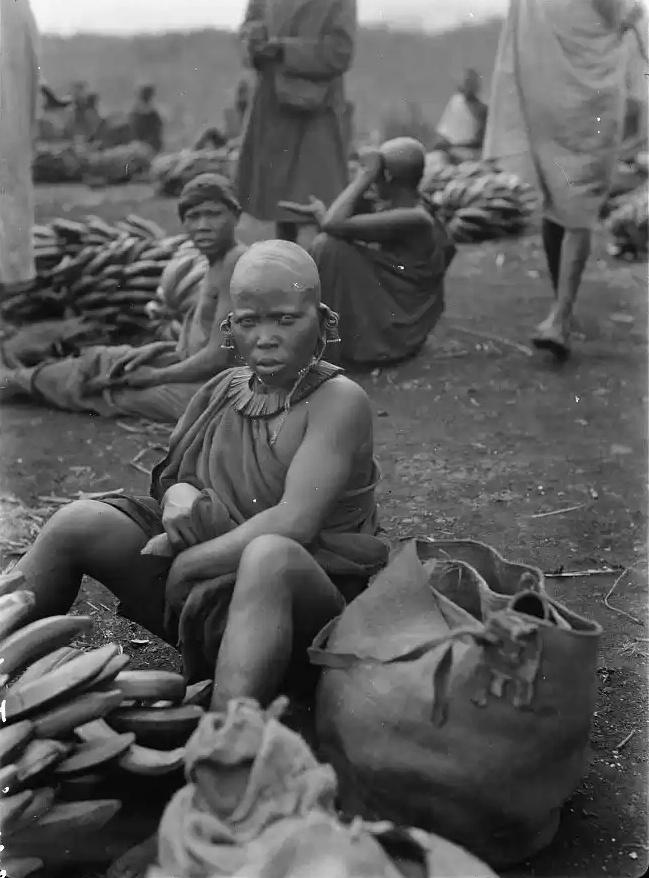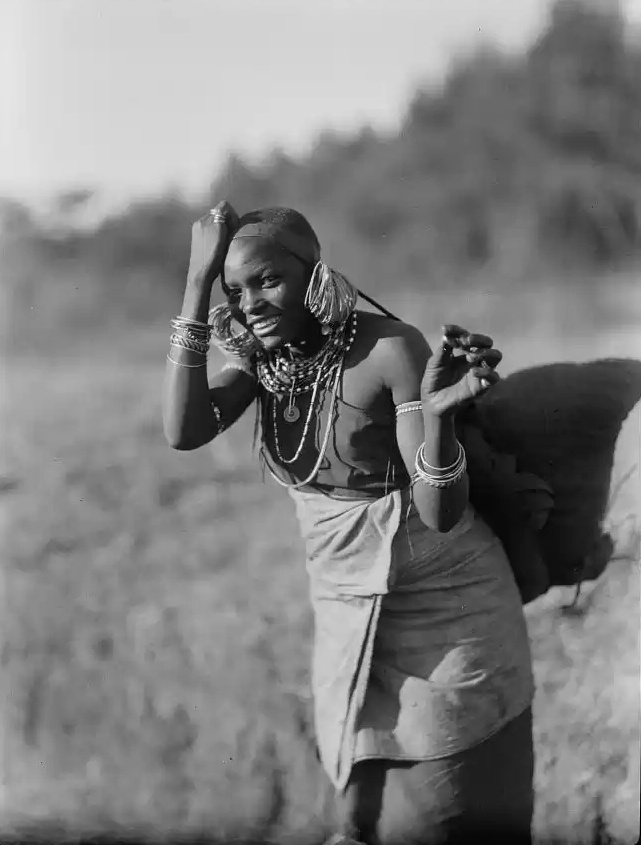We hereby present three fine antique photographs of Kikuyu women from the three traditional regions of Kikuyuland, Gaki – Nyeri, Metumi – Murang’a, and Kabete – Kiambu. The original photographs are all in the Library of Congress and are catalogued as having belonged to an Eric and Edith Matson taken on a 1936 flight with the Imperial Airways on a World Trunk route following the Nile from the delta to the Victoria Nile and the Victoria Lake. From their collection, it seems like the group visited Nairobi and neighbouring sisal and coffee estates up to Fort Hall, Murang’a and upcountry up to Nanyuki as well as Mombasa and Kisumu. It is while they were between Nairobi and Karatina that they stopped at Fort Hall, then Murang’a where they took the beautiful photo of the Murang’a woman. They stopped at Karatina where they took many photos of what they described as a native market under a tree and that is where they took the photograph of the Nyeri woman banana seller. The other photo of the Kiambu woman was taken as “Kikuyu Girl near Nairobi” on their way from Kisumu to Nairobi therefore we may conclude that she was a Kiambu woman.
Although it is a very small sample from which to draw conclusions, we can compare the combative unsmiling frown of the Nyeri woman with the comfortable smile and grace of the Murang’a woman. We can compare the Kiambu woman’s radiant smile and open hands with the Muranga closed but unconcealed hands and the Nyeri woman’s hidden hands. In terms of economics it is very clear; the Kiambu woman is the richest followed by the Murang’a and the Nyeri woman, though not poor comes last. All of them engage in commercial activity of one kind or other and it seems again, the Kiambu woman comes tops in terms of riches. The Muranga region was the breadbasket of Kikuyuland and the people were the best farmers of grains. Their stores were the richest and one of the reasons given for Francis Hall to have established a Fort in present day Murang’a town was that it was the best source of food. Kiambu women were more into exchanging articles with Maasai at Dagoreti market and it is apparent that our Kiambu woman has a lot of decorations associated with the Maasai. The true Kikuyu adornments for women can be seen from the Murang’a woman who among the three still retains her leather garments. The Kiambu woman is elegantly dressed in the white calico cloth that was introduced by the whites.
Each of these women is of course extremely attractive and it is a toss. Beauty is in the eye of the beholder.
1. Waithiegeni from Karatina, Nyeri
A slight frown
 Kikuyu woman in Karatina market -1936
Kikuyu woman in Karatina market -1936A woman’s economic status is judged from her adornments and general health. This is a very healthy woman judging from her physique. The arm is muscular and thighs and legs fleshy. She can wrestle any man easily to the ground. Today’s woman with her flabby arms and cellulite gasping after only one flight of stairs is a poor comparison to this healthy specimen who climbed the Nyeri hills while carrying heavy loads on her back. The strap for carrying loads on her back cut a mark on her clean shaven head. A clean shave was also a mark of being well groomed and clean. She seems to be of a medium income family neither rich nor poor. No exaggerated adornments of the ears and neck and wearing a single cloth tied over her right shoulder. She is a seller of bananas and looked at the photographer with suspicion and the usual Nyeri disdain, Rĩu ndũngana ici ikaigania kworota andũ na tũnyamũ tũtũ rĩ, mmmmmh? ungĩmoona!“ When will these bustards be satisfied with pointing those things at us?”
2. Wanjiru from Fort Hall, Muran’ga
A slight smile.
 An old woman near Fort Hall, Murang’a -1936
An old woman near Fort Hall, Murang’a -1936This beautiful picture is said to be of an old woman. The photographer seems to have had a better rapport with her and she seems more relaxed. She seems to have been resting and her load is next to her. She is adorned with the traditional beaded ear bangles, hang’i and the two iron spirals worn by married women. Her hang’i however are hanging from the earlobes and not strapped over her head as was the more common practice. In terms of health, again no modern Kikuyu woman can hold a candle to her even those half her age. The flabby arms and overflowing flesh from tummies and waists of today’s woman are not even worth talking about in front of such a physique.
3. Njeri from Kiambu
A radiant smile.
 Kikuyu girl near Nairobi – 1936
Kikuyu girl near Nairobi – 1936This fine picture reveals the beauty of soul of the Kiambu woman. She is a queen and is adorned as one and she knows it. Even if her husband may be poor and all the riches are due to her, no one will ever know it. We give her the name of Njeri aka Waceera, the traveller. Because of her journeys she is exposed to other cultures and trades with them. Her clothing betrays her Aceera clan ancestry, flamboyant, sharp and posh. She is alone as the saying goes, Mũceera ndaceeraga na ũngĩ, or “a Muceera does not travel with another”. Note that she wears rings on her fingers, a mark of royalty, that is, she is not a woman of dirt or grow arrow roots like our Nyeri or Murang’a specimens. Again her health is such that if we cared about our own health, we would do everything to learn the secret behind it and not believe the over glorified white coated prescription clerks for pharmaceutical companies who tell us only what is necessary to increase their business.
Quite an interesting read. Keep up with the good job sir! Mwene-Nyaga akurathime ni kugeria gucukia ruui mukaro.
LikeLike
Very informative. However, kindly clarify what it means, Muceera is not ‘ a woman of dirt or grow arrow roots like our Nyeri or Murang’a specimens ‘
LikeLike
Hi Zelipha
We fictionalised the pictures to make the Muranga woman a Wanjiru, the Nyeri woman a Waithiegeni and the Kiambu woman a Waceera or Njeri. The Aceera clan are sharp dressers and not short of vanity. If you see a guy in town driving a Maserati he is likely a Muceera and that was why we noted that the Muceera woman wears rings to show she is not associated with dirt but with travel. Today they are mostly in the diaspora. We never intended it as an insult to the other clans and we apologise if it came out thus.
LikeLiked by 1 person
Does it mean that to you that Aacera are only found in Kiambu?If not do the Aacera women in Muranga and Gaki also exhibit the asserted lifestyles?
LikeLike
Of cause the Aceera and even all the other clans are distributed in all regions though some regions have more concentrations of particular clans than others. The discussion of characteristics of each clan is a complex one and we are planning on an explanatory text soon.
LikeLike
Maaaan, You must be from Kabete!
LikeLike
Ha ha!! Sure!
LikeLike
Informative ……..the Kiambu woman 🙂 beutyfull in 2015
LikeLike
very fantastic
LikeLike
great read
LikeLike
Jk..u r madd..as usual
as usual…nice and funny read mr.evil
LikeLike
Ati evil? Beautifully evil u say. I like.
LikeLike
Note the woman from Gaki has very little bead work signifying very little outsider contact and she seems content with her looks. Her body language “what are you staring at”. Nyeri is 160kms from Nairobi and was less visited. The woman from Metumi has good beadworks signifying more outsider contact. Muranga is 100km from Nairobi but the boundary is only 60kms to Nrb. Her body language “We are used to being photographed”. The woman from Kabete has really amazing bead work. Its no coincidence but obviously she is more beauty conscious than all the others because of her numerous contact with visitors. She also looks more confident and as in the body language, she seems to acknowledge the admiration of the photographer and seems to be saying ” I wish you could have informed me and and l display my best”
LikeLiked by 1 person
Uhoro mwega atia!
LikeLike
In all the three instances the women are all hard workers.
LikeLike
and the one from kiambu is holding a coin! was she paid for the photo to be taken? maybe.
LikeLike
Good observation! Very likely a token of appreciation. Tourists even today do it when they photograph “natives”.
LikeLike
The ladies skirts seem rather short and they are not prudish to show their legs. Incidentally, where did the Kikuyu women with thin shins come from? These women have beautiful legs. Anyway they do have trim healthy bodies and this is a challenge for us modern women to keep fit like our ancestors
LikeLike
Wambui,
Short skirts is not unAfrican as we have been made to think by the missionaries. Skirts and legs were quite there then. See this post:
https://mukuyu.wordpress.com/2014/11/21/african-dress/
LikeLike
Very interesting treatise on the Kikuyu women. I am a Muithiegeni from Wariruta, Karatina. I think the woman from Gakii may be an ancestor. She looks very much like my aunty who incidentally sells foodstuff in Wariruta market. Thanks for sharing!
LikeLike
You’re crazy and your story is funny and educative 😉
LikeLike
The woman from Nyeri is very industrious she’s selling bananas that she got from her farm meaning she’s fed her whole family and is selling the surplus.
The surplus explains her physique that she’s a hardworking woman who ensures her children are well fed and her physique doesn’t mean it’s for wrestling men.
Her frown means she’s here for business not pleasure the photographer is wasting her time if they’re not buying.The frown could also mean she’s not fascinated by outside contact
LikeLike
Ni githomo kiega muno. Ni ngatho nyingi muno.
LikeLike
The usual Nyeri disdain, Rĩu ndũngana ici ikaigania kworota andũ na tũnyamũ tũtũ rĩ, mmmmmh? ungĩmoona!“ hahaha. That cracked me.
LikeLiked by 1 person
Not surprised. Going by freedom fighters statistics, Kabete 10%, Muranga 20% and Nyeri 70%. Sad that we had those who fought in suits and ties, homeguards, sweat and blood.
LikeLike
A good reading and exposition. However the article seems to reproduce and propagate the traditional stereotypes.
LikeLike
This is a good read and must be a well researched documentary. My observations are that its limited to the three photos to try and describe the entire Gikuyu Woman. You have done well to indicate your source of information though I feel you missed out on the original Home of Gikuyu and Mumbi, Kirinyaga. My I humbly suggest that this Muceera lady was near Nairobi and headed back Home after her exploits in the land of Mbu! You have done well, and you make us proud. There is need for a bigger platform for this. Tucokie rui mukaro. Thaai Thathaiya Ngai Thai!
LikeLike
What a great read
LikeLike
i feel honoured to see detailed tradition of my great tribe.
waoh!!!very proud to be kuke.
LikeLike